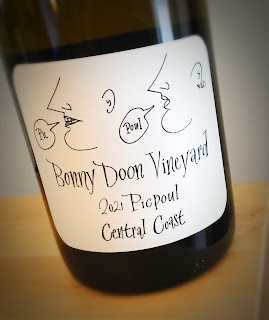One of the California wine world's constant beacons is undergoing a major facelift after 34 vintages.
Bonny Doon Vineyards winemaker
Randall Grahm (left) has made some significant changes to his flagship wine,
Le Cigare Volant, and its white counterpart,
Le Cigare Blanc.
Grahm says the way he made the Cigares previously kept the wines in the cellar for too long, at a time when people are saying that they want the world's finest wines, they want them here and they want them now - to paraphrase from "Withnail and I."
To make wines which are approachable earlier, Grahm dropped Mourvèdre from the red blend and increased the presence of Cinsault, a grape he considers to be greatly underappreciated. He doesn't see "rock-stardom" in Cinsault's future, but he does feel the grape is "soon to achieve its moment."
Le Cigare Blanc has also undergone a shakeup, with Vermentino replacing Roussanne in the white blend. Grahm calls that switch a "tectonic shift," saying that while Vermentino "might not have the gravitas of Roussanne ... I've found Roussanne to often be quite ponderous, and we are seeking elegance (and intelligence) above all."
Grahm has given the new versions of his wines the subtitled name of
Cuvée Oumuamua, after a cigar-shaped space object discovered by astronomers on Maui. The changes are reflected in the label picture, which shows a UFO shining a beam of light upon an unsuspecting vineyard. Colors have been added to the image, which Grahm says shines "a clarifying, and revivifying light on what had been a somewhat sepia-toned reality."
Both the 2018 Le Cigare Volant and Le Cigare Blanc retail for $20 and carry alcohol at 13.5% abv. Grahm produced 20,000 cases of the red, but less than 300 of the white. He feels, however, that the new Blanc is a "stylistic harbinger of LCBs of the future."
The 2018 vintage of Le Cigare Volant was made from 52% Grenache grapes, 35% Cinsault and 13% Syrah. They were harvested from Monterey County vineyards including: Alta Loma, Loma Del Rio, Mesa Verde, Zayante, Rancho Solo and Lieff.
The medium ruby colored wine gives off a fruity nose, a bit of a departure for Bonny Doon bottlings. The savory is not forgotten, but a healthy dose of raspberry, blackberry and red currant comes forward in unbridled fashion. On the palate, there's a tartness, but also a juicy acidity at play. To me, it drinks somewhat like a cru Beaujolais, only from Monterey County. The semi-lengthy finish carries the fruit well.
The 2018 Le Cigare Blanc was made from 54% Grenache Blanc grapes and 46% Vermentino from the Central Coast vineyards Cedar Lane, Paragon and Beeswax.
I'll admit, I miss the Roussanne, a favorite grape of mine. Fortunately, I love Vermentino, too, and it delivers enough salinity to be a worthy replacement. The nose threw me, because of its strong fruit'n'floral aromas. After a few minutes, the salinity came through and even more savory notes appeared on the nose. As with Le Cigare Volant, the Blanc is probably much more approachable in its new form. That may be great for sales, but it doesn't make me like it better.
Follow Randy Fuller on Twitter
























